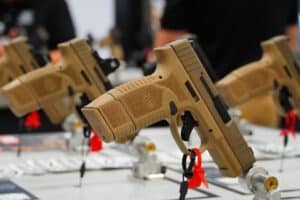The nation’s highest court will decide if the ATF exceeded its power by trying to ban the sale of unfinished firearms parts.
On Monday, the Supreme Court announced it would take up Vanderstok v. Garland. That case challenges the ATF’s rule against so-called “ghost guns,” which the agency adopted at the behest of President Joe Biden. A three-judge panel on the Fifth Circuit Court of Appeals found the rule “contrary to law” and ruled against the agency in October.
Now, the Supreme Court will have the ultimate say in whether the rule can stand.
The case is the second on the Court’s plate that deals with firearms but doesn’t directly implicate the Second Amendment. Back in February, the justices heard oral arguments in a challenge to the bump stock ban–a similar ATF-imposed ban from the Trump Administration that the Biden Administration has continued to defend. The outcome of either case may also implicate President Biden’s attempt to ban the sale of pistol-brace-equipped guns through ATF rulemaking and his gun agenda at large since he’s sought to tighten restrictions largely using that process.
In April 2022, the ATF finalized its rule redefining what constitutes a regulated firearm frame or receiver. The rule greatly expanded the ATF’s authority to determine when raw materials turn into guns under federal law. That allows them to target makers and dealers of unfinished frames and receivers, such as popular “80 percent” finished AR-15 receivers or pistol frames commonly used in homemade gun builds. If those popular unfinished parts are considered regulated firearms then any business making them would need to obtain a federal firearms license and engrave serial numbers on each one they produce. Additionally, any selling them would also need a license and would have to conduct an FBI background check on buyers.
The rule went into effect in August 2022 after a federal judge denied an early attempt to block it. US District Judge Peter D. Welte, a Trump appointee, rejected a Second Amendment challenge to the rule backed by 17 Republican Attorneys General.
“[I]n this Court’s view, the Final Rule was and remains constitutional under the Second Amendment,” he wrote in his opinion.
Judge Welte concluded the rule faced a lower burden because it didn’t completely ban unfinished firearms part or home gun making.
“The Final Rule does not infringe on any individuals’ or business’ ability to completely manufacturer a firearm for personal use, nor does it restrict the ability to obtain the weapon kits at issue,” “Instead, the Final Rule simply requires serialization of a firearm, when in the stream of commerce, so that it may be tracked in the event a crime is committed with the firearm. There is a longstanding distinction between the right to keep and bears arms and commercial regulation of firearm sales.”
The legal victory didn’t last long, though. Industry members and gun-rights activists won a preliminary injunction from US District Judge Reed O’Connor, a George W. Bush appointee, a few months later. His ruling came in on a different question about the rule: whether the ATF had the authority to make the changes it did.
“This case presents the question of whether the federal government may lawfully regulate partially manufactured firearm components, related firearm products, and other tools and materials in keeping with the Gun Control Act of 1968,” Judge O’Connor wrote in Vanderstok v. Garland. “Because the Court concludes that the government cannot regulate those items without violating federal law, the Court holds that the government’s recently enacted Final Rule… is unlawful agency action taken in excess of the ATF’s statutory jurisdiction. On this basis, the Court vacates the Final Rule.”
Instead of examining the ATF’s actions in the context of the Second Amendment, plaintiffs in Vanderstok asked Judge O’Connor to look at those actions in light of the Administrative Procedures Act. He found the ATF’s idea of what constitutes a “firearm” didn’t fit the definition provided by federal law and the agency didn’t have the power to re-write it.
“[T]he definition of “firearm” in the Gun Control Act does not cover all firearm parts. It covers specifically ‘the frame or receiver of any such weapon’ that Congress defined as a firearm,” he wrote. “And that which may become or may be converted to a functional receiver is not itself a receiver. Congress could have included firearm parts that ‘may readily be converted’ to frames or receivers, as it did with ‘weapons’ that ‘may readily be converted’ to fire a projectile. But it omitted that language when talking about frames and receivers.”
Judge O’Connor said the bottom line conclusion was simple.
“Because the Final Rule purports to regulate both firearm components that are not yet a ‘frame or receiver’ and aggregations of weapon parts not otherwise subject to its statutory authority, the Court holds that the ATF has acted in excess of its statutory jurisdiction by promulgating it,” he ruled.
The Supreme Court didn’t issue any comments alongside its decision to hear the case. However, it has already intervened in the case twice.
After Judge O’Connor issued his order vacating the ATF rule, he declined to stay his ruling pending appeal. The government then asked a three-judge panel for the Fifth Circuit Court of Appeals to implement one, but the panel sided with Judge O’Connor.
“Because the ATF has not demonstrated a strong likelihood of success on the merits, nor irreparable harm in the absence of a stay, we DENY the government’s request to stay the vacatur of the two challenged portions of the Rule,” the panel wrote in a per curiam opinion. “This effectively maintains, pending appeal, the status quo that existed for 54 years from 1968 to 2022.”
So, the government asked the Supreme Court itself to grant a stay. The Court disagreed with the Fifth Circuit’s rejection of a stay and issued one against Judge O’Connor’s decision to completely vacate the ATF’s rule, effectively allowing the agency to enforce its policies while the case continued. The Court ordered the stay to remain in effect until the end of the Fifth Circuit’s examination or until the Supreme Court itself decided the case.
“Justice Thomas, Justice Alito, Justice Gorsuch, and Justice Kavanaugh would deny the application for stay,” the order said. So, conservative Justices John Roberts and Amy Coney Barrett joined liberal Justices Sonya Sotomayor, Elana Kagan, and Ketanji Brown Jackson in granting the stay.
That sent the case back to Judge O’Connor, who then found against the rule on the merits and issued a new injunction blocking enforcement of the rule against anyone who owns the gun parts in question. The Fifth Circuit panel then agreed with Judge O’Connor’s finding that the rule was unlawful but narrowed the scope of his ruling to apply only to named plaintiffs 80 Percent Arms and Defense Distributed.
Still, when the government went back to the Supreme Court to ask for a stay of that ruling, the Court again obliged. It stayed the lower court’s injunction and allowed the ATF to continue enforcing its rule as the case played out (though the government had already assured the lower courts it didn’t plan to pursue charges against anyone while the legal fight continued).
Gabriel Malor, a legal commentator and federal appellate litigator, told The Reload in August that the stays aren’t out of the ordinary or predictive of how the case will turn out.
“The order is consistent with prior practice,” Malor said. “It should not be taken as an indication of where the justices stand on the merits.”
The Justices will now say exactly what they think of the merits of the challenge once the case is heard later this year.
UPDATE 4-22-2024 4:49 PM EASTERN: This piece has been updated with more background on the case.






